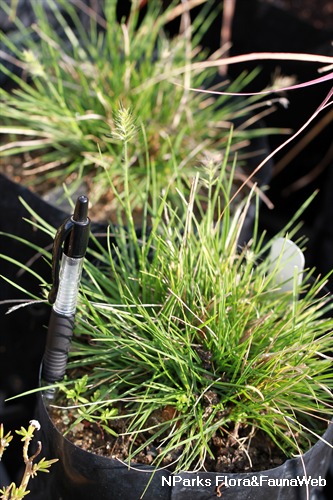
Back
Cenchrus purpurascens 'Little Bunny'
| Family Name: | Poaceae (Gramineae) |
| Synonyms: | Pennisetum alopecuroides 'Little Bunny' |
| Common Name: | Little Bunny Dwarf Fountain Grass |
Cenchrus purpurascens ‘Little Bunny’ or the Little Bunny Dwarf Fountain Grass, is one of the smallest cultivars of Fountain Grass standing at approximately 0.5m tall. This cultivar derived its common name from its inflorescence that resembles a rabbit’s puffy tail. Try to find the ‘bunny’s tail’ the next time you see this grass!
Name
Classifications and Characteristics
| Plant Division | Angiosperms (Flowering Seed Plants) (Monocotyledon) |
|---|---|
| Plant Growth Form | Grass or Grass-like Plant (Short Grass (Poaceae)) |
| Lifespan (in Singapore) | Perennial |
| Mode of Nutrition | Autotrophic |
| Plant Shape | Fountain (Palm-like) |
| Maximum Height | 30 cm to 45 cm |
| Maximum Plant Spread / Crown Width | 45 cm to 60 cm |
Biogeography
| Preferred Climate Zone | Temperate |
|---|---|
| Local Conservation Status | Non-native (Horticultural / Cultivated Only) |
Description and Ethnobotany
| Growth Form | One of the smallest dwarf cultivars of Fountain Grass, growing up to 0.5 m tall. |
|---|---|
| Flowers | Spike inflorescence is a short, hairy structure that resembles a bunny's tail. It is composed of whitish green to white spikelets which contain the florets (reduced flowers lacking petals or sepals). |
| Fruit | Dry, indehiscent fruit is known as a caryopsis. Mature fruits are yellowish beige to tan. |
| Others - Plant Morphology | This cultivar was derived from a Pennisetum alopecuroides 'Hameln' seedling. |
| Cultivation | This cultivar needs regular moisture, but is drought tolerant when established. It grows best in full sun or light shade. |
| Ethnobotanical Uses | Cut - Dried Flower: The inflorescence is attractive both fresh and dried. |
Landscaping Features
| Desirable Plant Features | Ornamental Flowers, Ornamental Form |
|---|---|
| Landscape Uses | Small Gardens, Flowerbed / Border, Groundcover, Container Planting, Slope Stabilization |
Plant Care and Propagation
| Light Preference | Full Sun |
|---|---|
| Water Preference | Moderate Water |
| Rootzone Tolerance | Drought Tolerant, Well-Drained Soils, Fertile Loamy Soils, Polluted Air |
| Maintenance Requirements | Low |
| Propagation Method | Seed |
| Plant Growth Rate Remarks | Slow |
Foliar
| Foliage Retention | Evergreen |
|---|---|
| Mature Foliage Colour(s) | Green |
| Foliar Type | Simple / Unifoliate |
| Foliar Attachment to Stem | Sessile |
| Foliar Shape(s) | Non-Palm Foliage (Linear) |
| Foliar Venation | Parallel |
| Foliar Margin | Entire |
| Foliar Apex - Tip | Acute |
Floral (Angiosperm)
| Flower & Plant Sexuality | Bisexual Flowers |
| Flower Colour(s) | White |
|---|---|
| Flower Texture(s) | Hairy / Hirsute |
| Flower Grouping | Cluster / Inflorescence |
| Flower Location | Terminal |
| Flower Symmetry | Asymmetrical |
| Inflorescence Type | Spikelet / Compound Spike |
| Flowering Habit | Polycarpic |
| Flower Colour(s) Remarks | Whitish Green |
Fruit, Seed and Spore
| Mature Fruit Texture(s) | Hairy / Hirsute |
|---|---|
| Fruit Classification | Simple Fruit |
| Fruit Type | Indehiscent Dry Fruit , Caryopsis / Grain |
| Mature Seed Colour(s) | White |
| Mature Seed Texture(s) | Hairy / Hirsute |
| Seed Quantity Per Fruit | Few (1-5) |
Image Repository
Others
| Master ID | 31779 |
|---|---|
| Species ID | 6179 |
| Flora Disclaimer | The information in this website has been compiled from reliable sources, such as reference works on medicinal plants. It is not a substitute for medical advice or treatment and NParks does not purport to provide any medical advice. Readers should always consult his/her physician before using or consuming a plant for medicinal purposes. |





